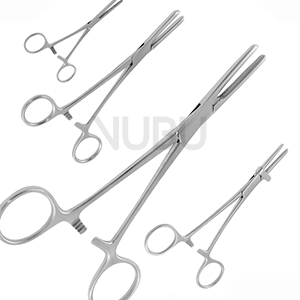Tubing clamps are specialized instruments designed to securely clamp medical tubing made of silicone or other flexible materials, regulating the flow of liquids or gases. They are indispensable tools in a wide range of medical applications, from infusion therapy to anesthesia. Thanks to their thoughtful design, they ensure precise control without compromising the integrity of the tubing.
Jaw Construction: The jaws of tubing clamps can be either smooth or cross-serrated. While smooth jaws allow for gentle handling, cross-serrated jaws provide a particularly secure grip to prevent the tubing from slipping.
Material: The clamps are made from high-quality stainless steel or plastic-coated metal to ensure high resistance to corrosion and sterilizability. This makes them both durable and hygienic.
Ergonomics: The ergonomic design of the clamps allows for easy and precise handling, even during lengthy or complex medical procedures.
Variants: Tubing clamps are available in various sizes and designs to accommodate different tubing diameters and medical requirements.
Infusion Therapy: Tubing clamps are used to regulate the flow of infusion solutions, such as during intravenous fluid administration or medication delivery.
Anesthesia: They are used to control gas flow in tubing during anesthesia or ventilation.
Drainage Systems: Tubing clamps are employed to manage fluid flow in drainage tubing, for example, after surgical procedures.
Laboratory Medicine: In laboratory settings, they are used to regulate the flow of samples or reagents in tubing.
Safety: The clamps ensure a secure grip on the tubing without damaging or crushing it.
Precision: They allow for fine control of the flow of liquids or gases, which is particularly important in critical medical situations.
Versatility: The availability of various sizes and designs allows them to be adapted to a wide range of tubing types.
Hygiene: The sterilizable materials ensure high hygiene standards and reduce the risk of infections.
Among the most well-known and proven tubing clamps are models such as the Rochester clamp and the Roller clamp. These instruments are renowned for their reliability and user-friendliness:
Rochester Clamp:
Description: A robust clamp with smooth or serrated jaws that provide a secure grip on medical tubing.
Applications: Ideal for infusion therapy and drainage systems.
Advantages: Easy handling and precise flow control.
Roller Clamp:
Description: A clamp with a roller mechanism that allows for fine flow regulation.
Applications: Frequently used in anesthesia and laboratory medicine.
Advantages: Precise control and minimal tubing stress.
Our tubing clamps undergo strict quality control and comply with international standards for medical instruments, including DIN ISO 13485 and 9001. This ensures that each instrument meets the highest requirements for safety, effectiveness, and durability. Additionally, our clamps are CE-certified, confirming their compliance with European regulations.
Sustainability: The use of durable materials contributes to the reduction of medical waste.
User-Friendliness: The ergonomic design reduces hand fatigue and enables precise control.
Adaptability: Available in various sizes and configurations to meet the demands of different medical procedures.
Tubing clamps are indispensable tools in medical care. With proven models such as the Rochester clamp and the Roller clamp, we offer instruments that stand out for their precision, safety, and versatility. By adhering to the highest quality standards and using premium materials, we ensure that our clamps meet the demands of complex medical procedures.
